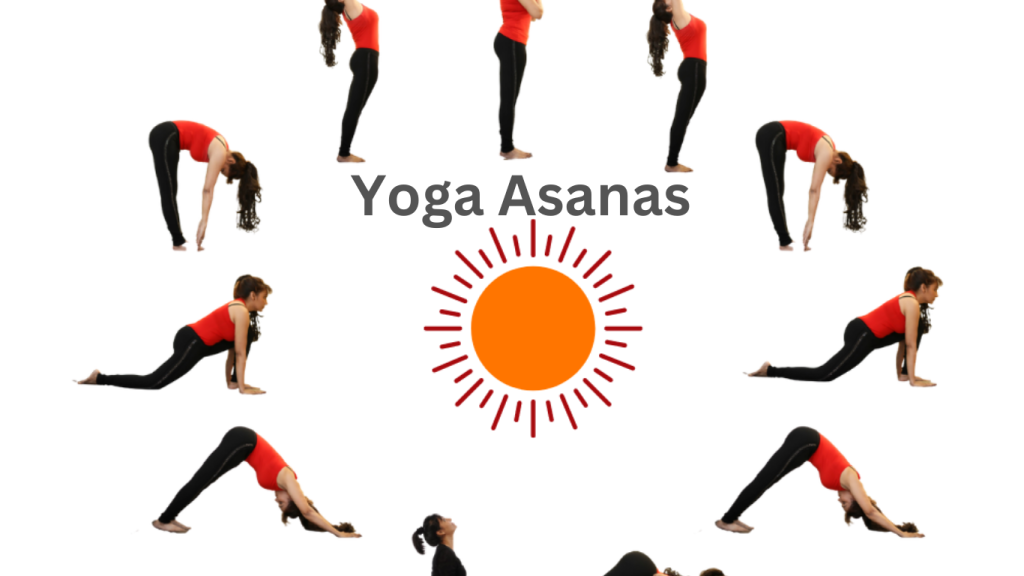
Yoga asanas, or physical postures, are a fundamental part of yoga practice. There are many different types of asanas, each designed to achieve specific benefits for the body, mind, and spirit. Below is a breakdown of some of the most common types of yoga asanas, categorized based on their purpose and the type of stretch or engagement they offer.
1. Standing Poses
- Purpose: Build strength, stability, and balance.
- Examples:
- Warrior I (Virabhadrasana I): A powerful pose that strengthens the legs, stretches the hips, and opens the chest.
- Warrior II (Virabhadrasana II): Helps improve leg strength, balance, and mental focus while opening the hips and chest.
- Mountain Pose (Tadasana): A foundational pose for alignment, posture, and grounding.
- Tree Pose (Vrksasana): Improves balance and mental focus while strengthening the legs and opening the hips.
2. Seated Poses
- Purpose: Increase flexibility, especially in the hips and lower back, and calm the mind.
- Examples:
- Easy Pose (Sukhasana): A comfortable seated pose used for meditation or breathing exercises.
- Staff Pose (Dandasana): Strengthens the back and core, helping improve posture.
- Seated Forward Bend (Paschimottanasana): Stretches the hamstrings and spine, calming the mind.
- Bound Angle Pose (Baddha Konasana): Opens the hips and groins, stretches the inner thighs, and calms the mind.
3. Backbends
- Purpose: Open the chest and heart, increase spinal flexibility, and energize the body.
- Examples:
- Cobra Pose (Bhujangasana): A gentle backbend that stretches the chest, shoulders, and spine.
- Bridge Pose (Setu Bandhasana): Opens the chest and hips, strengthens the legs and lower back.
- Camel Pose (Ustrasana): A deep backbend that opens the chest, shoulders, and hip flexors.
- Wheel Pose (Urdhva Dhanurasana): A challenging backbend that strengthens the arms, chest, and legs while opening the spine.
4. Balance Poses
- Purpose: Improve concentration, balance, and coordination.
- Examples:
- Eagle Pose (Garudasana): A balancing pose that strengthens the legs and arms, improves concentration, and stretches the shoulders and hips.
- Chair Pose (Utkatasana): Strengthens the legs, core, and arms while improving balance and focus.
- Half Moon Pose (Ardha Chandrasana): A standing balance that stretches the hamstrings, hips, and spine while improving stability.
5. Inversions
- Purpose: Improve circulation, strengthen the core, and promote a sense of calm and focus.
- Examples:
- Downward Dog (Adho Mukha Svanasana): A classic inversion that stretches the body from head to heels and calms the mind.
- Shoulder Stand (Sarvangasana): An inversion that increases blood flow to the upper body, relieves tension, and strengthens the shoulders and neck.
- Headstand (Sirsasana): A more advanced inversion that improves circulation, core strength, and mental clarity.
6. Twists
- Purpose: Detoxify the body, improve spinal flexibility, and stretch the back and shoulders.
- Examples:
- Seated Twist (Ardha Matsyendrasana): A seated posture that improves spinal flexibility and stretches the shoulders and hips.
- Revolved Triangle Pose (Parivrtta Trikonasana): A standing twist that stretches the hamstrings, spine, and hips while improving digestion.
- Supine Spinal Twist (Supta Matsyendrasana): A gentle twist performed lying on your back to release tension in the spine and hips.
7. Hip Openers
- Purpose: Increase flexibility and mobility in the hips and groin.
- Examples:
- Pigeon Pose (Eka Pada Rajakapotasana): A deep hip opener that stretches the hip flexors, glutes, and lower back.
- Lizard Pose (Utthan Pristhasana): A deep stretch for the hips, groins, and thighs.
- Cow Face Pose (Gomukhasana): Stretches the hips, thighs, and shoulders, promoting flexibility and relaxation.
8. Restorative and Relaxation Poses
- Purpose: Promote relaxation, reduce stress, and calm the nervous system.
- Examples:
- Child’s Pose (Balasana): A restorative posture that gently stretches the back and hips while calming the mind.
- Corpse Pose (Savasana): A relaxation pose practiced at the end of a yoga session, helping the body and mind integrate the practice.
- Legs Up the Wall (Viparita Karani): A gentle inversion that promotes relaxation and aids in recovery.
9. Core Strengthening Poses
- Purpose: Engage and strengthen the muscles of the abdomen and lower back.
- Examples:
- Plank Pose (Phalakasana): Strengthens the core, arms, and shoulders.
- Boat Pose (Navasana): A core-centric pose that targets the abdominal muscles and promotes stability.
- Side Plank Pose (Vasisthasana): Strengthens the core and arms while improving balance and stability.
10. Standing Forward Bends
- Purpose: Stretch the hamstrings, lower back, and hips while calming the mind.
- Examples:
- Forward Fold (Uttanasana): A standing posture that stretches the hamstrings, calves, and spine while calming the nervous system.
- Wide-Legged Forward Bend (Prasarita Padottanasana): Stretches the hamstrings, hips, and back, while helping with balance and alignment.
Each yoga asana has specific benefits and can be practiced alone or as part of a sequence, depending on your goals. Practicing a variety of asanas helps maintain physical balance and flexibility while promoting mental focus and emotional well-being.